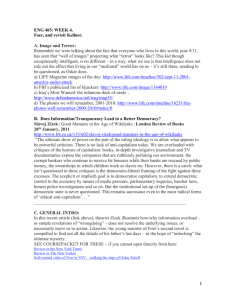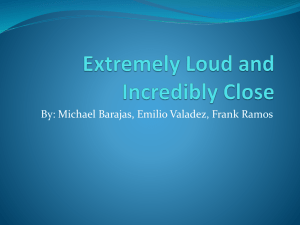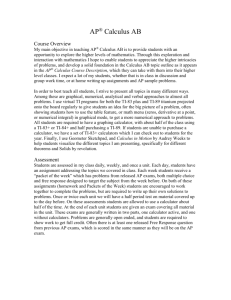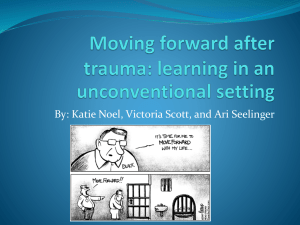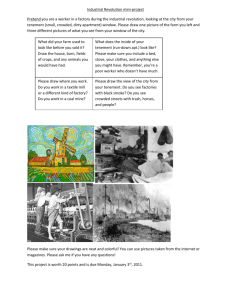The Australian Reforming the farm Annemarie Jonson From: The
advertisement
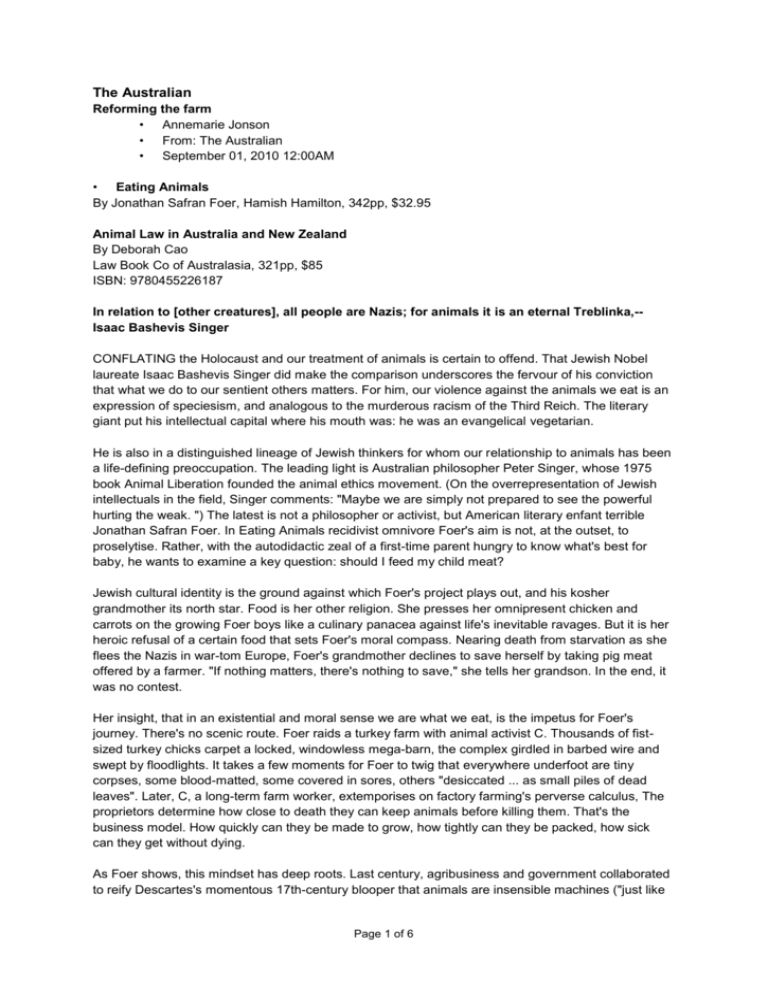
The Australian Reforming the farm • Annemarie Jonson • From: The Australian • September 01, 2010 12:00AM • Eating Animals By Jonathan Safran Foer, Hamish Hamilton, 342pp, $32.95 Animal Law in Australia and New Zealand By Deborah Cao Law Book Co of Australasia, 321pp, $85 ISBN: 9780455226187 In relation to [other creatures], all people are Nazis; for animals it is an eternal Treblinka,-Isaac Bashevis Singer CONFLATING the Holocaust and our treatment of animals is certain to offend. That Jewish Nobel laureate Isaac Bashevis Singer did make the comparison underscores the fervour of his conviction that what we do to our sentient others matters. For him, our violence against the animals we eat is an expression of speciesism, and analogous to the murderous racism of the Third Reich. The literary giant put his intellectual capital where his mouth was: he was an evangelical vegetarian. He is also in a distinguished lineage of Jewish thinkers for whom our relationship to animals has been a life-defining preoccupation. The leading light is Australian philosopher Peter Singer, whose 1975 book Animal Liberation founded the animal ethics movement. (On the overrepresentation of Jewish intellectuals in the field, Singer comments: "Maybe we are simply not prepared to see the powerful hurting the weak. ") The latest is not a philosopher or activist, but American literary enfant terrible Jonathan Safran Foer. In Eating Animals recidivist omnivore Foer's aim is not, at the outset, to proselytise. Rather, with the autodidactic zeal of a first-time parent hungry to know what's best for baby, he wants to examine a key question: should I feed my child meat? Jewish cultural identity is the ground against which Foer's project plays out, and his kosher grandmother its north star. Food is her other religion. She presses her omnipresent chicken and carrots on the growing Foer boys like a culinary panacea against life's inevitable ravages. But it is her heroic refusal of a certain food that sets Foer's moral compass. Nearing death from starvation as she flees the Nazis in war-tom Europe, Foer's grandmother declines to save herself by taking pig meat offered by a farmer. "If nothing matters, there's nothing to save," she tells her grandson. In the end, it was no contest. Her insight, that in an existential and moral sense we are what we eat, is the impetus for Foer's journey. There's no scenic route. Foer raids a turkey farm with animal activist C. Thousands of fistsized turkey chicks carpet a locked, windowless mega-barn, the complex girdled in barbed wire and swept by floodlights. It takes a few moments for Foer to twig that everywhere underfoot are tiny corpses, some blood-matted, some covered in sores, others "desiccated ... as small piles of dead leaves". Later, C, a long-term farm worker, extemporises on factory farming's perverse calculus, The proprietors determine how close to death they can keep animals before killing them. That's the business model. How quickly can they be made to grow, how tightly can they be packed, how sick can they get without dying. As Foer shows, this mindset has deep roots. Last century, agribusiness and government collaborated to reify Descartes's momentous 17th-century blooper that animals are insensible machines ("just like Page 1 of 6 in a factory", according to a I 970s pig industry journal). Genetic manipulation by selective breeding, the transformation from traditional farming to intensive indoor confinement and the routine use of pharmaceuticals to suppress disease and speed development produced neoplastic growth rates and freakish conversion ratios of feed to product (meat, milk, eggs). In the 60 years to 1995, the weight of American broiler chickens increased by 65 per cent, while time to market and feed volumes dropped about 60 per cent. Simultaneously, animal agribusiness massively upscaled, as corporate entities displaced smaller family farms. All of the above had the effect of driving production costs and retail prices down while maximising profitability. Now everybody's happy. Americans eat more animal protein per capita than any culture in history -- 150 times more chicken than 80 years ago -- and they pay historically little for it. And big agribusiness laughs all the way to the bank. (According to Australian animal welfare group Voiceless, local chicken production has increased 15,000 per cent since the 50s, and three large players dominate the industry.) It's the animals who pay. As we soon learn, Turkeys R Us was a walk in the park compared with the serial atrocities to which Foer's quest will expose him; second-hand, as it happens, since no factory farm would allow him access. As Foer discovers, intensive animal production in the US relies on its invisibility to the public to maintain the status quo (as is arguably the case here, too). With animal factories hidden from public view, consumers are able to plead ignorance or to entertain the assumption that their nostalgic, Old Macdonald's Farm-style images of food production still pertain. The delusion is abetted by misleading labelling such as "free range", "all natural" or "fresh" on frozen, factory-farmed, sometimes pathogen-infected produce. The industry's aversion to transparency and public scrutiny is doubly problematic, Foer says, because "welfare" regulations that purport to enshrine humane treatment for farm animals instead deny them material safeguards against cruelty. Deborah Cao's Animal Law in Australia and New Zealand suggests this is also the case here. Under Australian legislative and regulatory codes, animals in agribusiness languish largely unprotected against institutionalised abuse. In the absence of a meaningful justice framework for farm animals, these industrial, economic and scientific forces have culminated in what Foer, invoking Jacques Derrida, characterises as a war. This war entails the violation of animals on a scale previously unknown. The factory farm and slaughterhouse are its battlefields. Foer chronicles the plight of the factory-farmed broiler chicken in the US. Engineered to produce meat at four times the daily rate of their 30s counterparts, they endure their truncated 40 days of life jammed with tens of thousands of others in a feculent shed, allotted 743sq cm of floor space, pumped with drugs and awake under lights 20-plus hours a day. Distress, disease and injury are rife (threequarters are lame and most harbour E. coli). Thousands die. When their time's up, the surviving birds are manhandled into transport crates; one-third suffer broken bones. At the slaughterhouse, they are shackled upside down (more bones broken), paralysed by immersion in electrified water, and have their throats mechanically slit. Bungled slaughter means millions of birds go alive into the scalding tank. Next, their heads are pulled off and their feet amputated, before they're gutted and cooled in gargantuan vats of chilled water, shorthanded as "fecal soup". Sometimes, writes Foer, dying birds "will have enough control of their bodies to slowly open their mouths, as if attempting to scream". Each year, 50 billion birds worldwide live and die like this. In Australia, more than 470 million broilers are produced annually. Page 2 of 6 Better known is the misery of the battery-caged "layer" hen. Custom-manufactured to produce eggs (as opposed to meat), her output is twice that of her 30s forebears. "Spent" after about a year, she is cruelly slaughtered. Meantime, her useless male chicks -- good for neither meat nor eggs -- are electrocuted, suffocated or macerated (placed alive in a grinder). Gassing and maceration are favoured in Australia. The situation is little better for other animals. Foer asks us to consider the nightmarish life of the American factory farmed sow. The profit motive dictates that she is designed to be hyper-fertile, producing up to nine piglets per litter. Each l6-week gestation will be followed by another artificial insemination. Her home will be a "gestation crate" (a sow stall in Australia) so small she will not be able to tum around. With no material for bedding -- outdoors, expectant pigs roam widely to forage for grass or leaves to build a nest -- and closely confined in her metal and concrete cage, she wiII likely develop widespread suppurating skin ulcerations. She will lie in her own waste, immobilisation will weaken her bones and she will be prone to deformity and disease. Deprived of stimulus, and with her powerful desire to prepare for her Jitter frustrated, she will become distressed. She m1\Y be in the seven to 15 per cent who die. Or this highly intelligent being, with cognitive abilities comparable to a chimpanzee may, says Foer, "go insane", obsessively gnawing on the bars, of her cage. ;I For birthing, she'll be forced into a constrictive farrowing crate (as is the case here). Foer quotes a worker who finds it necessary to "beat the shit out" of pregnant pigs to get them inside because they typically "don't want to go". Her piglets will also suffer, as Foer unsparingly details. Their tails and "needle" teeth will be cut off and males will have their testicles "tom out" to satisfy consumers' taste preference for castrated animals. Weaned at 15 or so days so they can be fattened for slaughter -- left alone, the piglets would suckle for 15 weeks -- they are too young to tolerate solids, so they are fed pharmaceuticals to suppress diarrhoea. Nine to 15 per cent will die. After weaning, the piglets will be moved into cramped pens, where relative immobility means they require less food ("overcrowding pigs pays"). Here, they are treated with a cocktail of drugs to keep them alive till slaughter. Thirty to 70 per cent will have respiratory disease when they are killed, the consequence of their living conditions, including the miasma of excrement in which they subsist. Any "runts" will have been "euthanased" by being bashed headfirst on concrete. In Australia, the pig "welfare" code authorises euthanasia by blunt trauma to the head with a hammer. And there is more. Perhaps Foer's principal accomplishment in Eating Animals is the exhaustiveness of the case he makes. Factory farming is an abomination whichever way you look at it. If "the most systematic animal abuse in world history" doesn't do it for you, Foer enumerates the devastating toll of animal agribusiness on the environment, on human health and on workers. These extemalised costs, as Foer styles them, are not reflected in the $4.99 you stump up when you bring home the bacon. Oh, but we will pay. Foer quotes UN research that identifies animal agriculture as the single biggest driver of climate change, responsible for 18 per cent of greenhouse gas emissions, more than all forms of transport combined. It is a leading contributor to the world's most serious ecological problems, including land degradation, deforestation and loss of biodiversity. Intensive animal farming produces prodigious volumes of shit and slaughterhouse waste, polluting waterways, killing fish and damaging human health. Industrial fishing, the aquatic complement of factory farming, likewise, ravages marine life and ecosystems. Foer tells us that omnivores' carbon footprint is seven times that of vegans. He concludes that omnivore environmentalist is an oxymoron. Added to all this, Foer warns, is the risk of a global pandemic caused by a "zoonotic" super-pathogen: a virus that jumps the species barrier between humans and other animals. The engine of this Page 3 of 6 pathogenesis is increased demand for animal protein driving the intensive confinement of chickens and pigs. We've recently had an inkling of viral Armageddon in the swine flu epidemic, which originated in a factory farm. We dodged that bullet, but our luck will run out, Foer predicts. The US National Academy of Sciences and WHO have warned that a catastrophic pandemic is inevitable and overdue. Equally alarming is increasing antibiotic resistance in humans, fuelled by the routine use of millions of kilograms of antimicrobials on factory-farmed animals each year. For Foer, the "absurd economics" of intensive farming are so "radically unsustainable" its whole edifice is destined for collapse. The only question, he thinks, is whether our species will get out alive. For the weakest and the poorest, factory farming is already a catastrophe, and their predicament is another key theme in Foer's book. He quotes research showing that animal agriculture uses 756 million tonnes of grain and com per year, more than enough for the 1.4 billion humans in dire poverty. That's not counting the global soy crop of 225 million tonnes, 98 per cent of which is fed to animals. By 2050, Foer tells us, factory farmed animals will eat as much as four billion people. Animal agribusiness also brutalises the "human capital" closest to it. In the US, minimum-wage immigrant and alien workers labour in conditions that constitute human rights violations, Foer contends. Impossible processing line speeds translate to untenable kill quotas and botched kills. Injury rates and turnover are sky high. Dehumanised workers pay it forward, acting out sadistically on terrified, dying animals. Foer describes conscious cows being skinned and dismembered, workers stomping on chickens until they pop, a slaughterhouse worker slicing off a pig's snout. Citing industry audits, Foer says acts of this nature ate not aberrations, but regular and systemic. Is there anything right with this picture? Well, Foer is attentive to the work of a handful of independent, predominantly family-run concerns. To varying degrees, these honour their ethical obligations to provide .animals a good life and swift death. As a response to agribusiness's rapacious behemoth, however, their efforts seem doomed. In the US alone, 10 billion land animals are processed each year, 99 per cent of them in factory farms. Globally, intensive animal industries manufacture and kill450 billion animals a year. "Ethical meat is a promissory, note," Foer writes, "not a reality." He has his answer: "To accept the factory farm feels inhuman ... To feed the food it produces to my family, to support it with my money ... makes me less myself, less my grandmother's grandson, less my son's father." In the end, it is no contest. IN Australia, more than 90 per cent of food animals are factory farmed, according to Animal Law in Australia and New Zealand. This is about half a billion per year. These animals are a central concern of Deborah Cao's landmark book, the first introductory legal text on this topic in this country, and the second major scholarly volume in the area after last year's groundbreaking Animal Law in Australasia, edited by Peter Sankoff and Steven White. Cao's book, with contributions by White and Katrina Sharman, is timely: in the view of jurisprudential luminaries such as David Weisbrot, former president of the Australian Law Reform Commission, and Michael Kirby, animal protection is emerging as the next great social justice movement. Kirby, who has compared the situation of animals with slaves, writes in the preface of his own conversion to vegetarianism. The book accompanies the establishment of animal law courses at several leading universities, another sign of the increasing attention of the profession to justice for animals. It illuminates the philosophical, scientific and juridical underpinnings of contemporary animal law, and provides a thoroughgoing overview of laws relating to farm animals, companion animals, wildlife and animals used in research. Page 4 of 6 Cao traces the legal status of animals to enduring Western religious, intellectual and legal traditions that classify animals as a resource or property, devoid of moral standing. As she shows, this moral anthropocentrism is consistent with the philosophical view that animals lack sentience (Descartes) or rationality (Aristotle, Kant). In the past 40 years, this view has been widely challenged, Cao writes, opening the way for consideration of the interests of animals -- including of those "raised and slaughtered in conditions that cause them enormous suffering" -- as a serious moral issue. Cao adroitly reviews the key schools of thought in animal ethics. These include rights theory, which asserts non-human animals have intrinsic value as "experiencing subjects of a life", the relative newcomer, virtue ethics, and utilitarianism, of which Singer is the leading representative. In utilitarianism, interests are assigned on the basis of sentience. Since animals are sentient, they have "direct moral status" and are entitled to equal consideration. A refusal to consider the interests of sentient non-humans constitutes speciesism, "an ethically indefensible form of discrimination" comparable to racism and sexism. The cornerstone of utilitarian animal ethics is 18th-century philosopher Jeremy Bentham's insight that "The question is not, 'Can [animals] reason?' Nor 'Can they talk?' But 'Can they suffer?.' " Should any stray Cartesians maintain that animals are organic automata, Cao marshals the overwhelming scientific evidence to contrary. As she shows, the consensus is that animals, like us, are "capable of being aware of sensations and emotions, and of feeling pain and suffering". Moreover, a substantial body of research shows animals are not only sentient, but have complex mental and emotional lives. Here Cao touches on Singer's observation that many animals possess greater cognitive capacities than some humans, including the intellectually disabled and infants; if it is not morally justified to harm these humans, the question is on what grounds are we justified in inflicting suffering on animals? Sentience, however, remains the threshold philosophical, ethical and legal test that shapes our response to animals. And, crucially, animals' capacity to feel is the basis for welfare considerations that find expression in laws designed to protect them. For farm animals in Australia, moral imperative and legal reality couldn't be further apart. As Sharman, in-house counsel for Voiceless, writes, farm animals have "no fundamental legal rights". A farm animal's legal status is as a resource or property, not as a sentient being. Most fall outside the protective reach of the law despite the presence of a "complex regulatory structure that purports to protect them". Our system, it seems, shares some features with the regulatory framework in the US that Foer alludes to. For example, the commonwealth Department of Agriculture plays a role in regulating the treatment of farm animals, as the US Department of Agriculture does. Sharman remarks that the department and its associated bodies are subject to a fundamental conflict of interest: since their central objective is to foster the profitability of agribusiness, the interests of farm animals are compromised. Foer, likewise, 'suggests that USDA oversight entrenches cruelty in the name of industry efficiencies. In Australia, the animal welfare codes established by the Primary Industries Ministerial Council epitomise this problem. These codes facilitate brutal mistreatment, including intensive confinement in factory farming. The Pig Code, for example, sanctions the sow stalls that produce so much misery (these structures are illegal in many international jurisdictions). As Sharman remarks, the codes permit practices that would give rise to criminal proceedings if the "victim" was a domestic animal and not, ultimately, an industrialised food product. Primary responsibility for the development and enforcement of animal welfare legislation rests with states, where farm animals fall under the provisions .of anti-cruelty laws. This is a concern, Sharman says, as it creates misperception that animals on farms are protected. These laws include Page 5 of 6 qualifications that prohibit, for example, "unreasonably, unnecessarily or unjustifiably" harming an animal. As Sharman shows, the effect of these "welfare words" is that widespread cruelty to farm animals is deemed "justifiable, reasonable and necessary" on economic grounds. The live export trade is a case in point. Moreover, some laws expressly sanction cruelty, Sharman argues. Laws on cage sizes for battery hens allows space equivalent to an A4 page per bird. In Australia, farm animals' vulnerability to abuse is compounded by "exemptions and defences" in anti-cruelty legislation. Acts that would otherwise be unlawful are sanctioned if they constitute "accepted animal husbandry practice". These provisions appear to correspond to the US's "Common Farming Exemptions", which, Foer writes, legalise anything agribusiness does to animals as long as its common practice. In both countries, the exemptions empower those who profit from factory farming to decide what constitutes cruelty to animals, with the predictable effects. Finally, serious inadequacies in law enforcement and the invisibility of animal factories mean only the tiniest smattering of the very worst cases of cruelty ever see the judicial light of day. Sharman shows that abuse of the half-billion animals farmed in this country each year is widespread, institutionalised and legal. Since they don't talk, but they do suffer, law reform is a moral imperative. IN J. M. Coetzee's The Lives of Animals; the protagonist Elizabeth Costello is a celebrated novelist facing senescence and its intimations of mortality. She is consumed by an idee fixe; that humankind's collaboration in the violation of the animals we eat is the most egregious of wrongs: "We are surrounded by an enterprise of degradation, cruelty and killing which rivals anything the Third Reich was capable of." Her conviction puts her painfully at odds with her fellow human beings. To her mind, they are complicit in "a crime of stupefying proportions". The evidence is everywhere. People offer her "Corpses. Fragments of corpses that they have bought for money." She imagines visiting friends: "It's as if ... I go to the bathroom and the soap-wrapper says 'Treblinka -- 100 per cent human stearate'." For Costello, the cardinal horror of the death camps was this: the people, in their willed ignorance, "refused to think themselves into the place of the victims ... They did not say, How would it be if it were I in that cattle-car?' " They "closed their hearts" and "lost their humanity". Today, the people all around her seem human enough. She moves "perfectly easily" among them. They even have "kindness, humankindness" in their eyes. But they too, inexplicably, "close their hearts" to the "places of death all around", to each day's "fresh holocaust". It's an insoluble perplexity. She can't reconcile it. Because to be human means that "there is no limit to the extent to which we can think ourselves into the being of another". These two books are testament to that conviction. Copyright 2010 News Limited. All times AEST(GMT+10). Page 6 of 6
